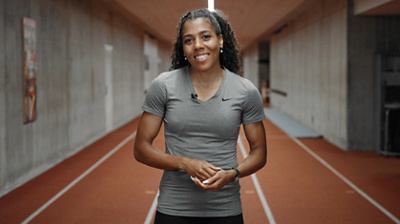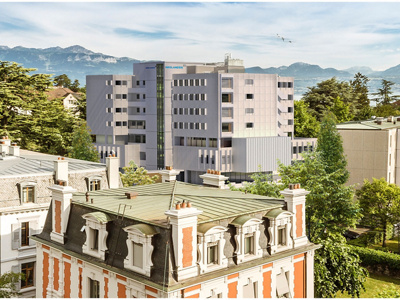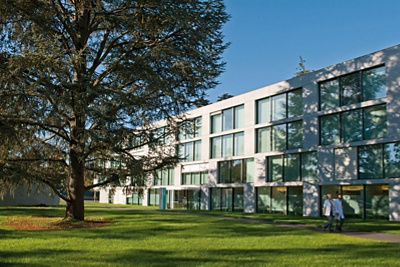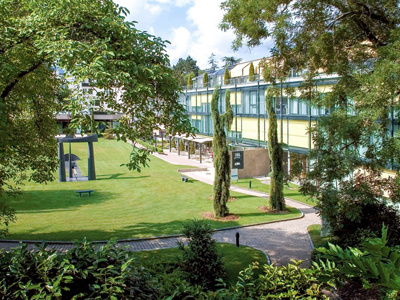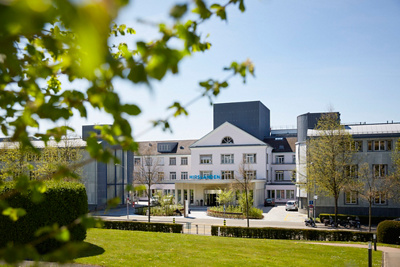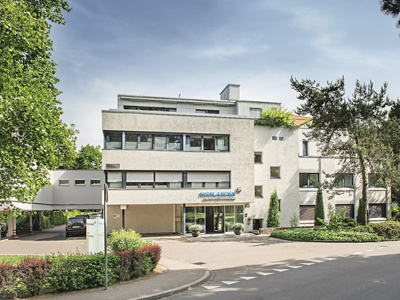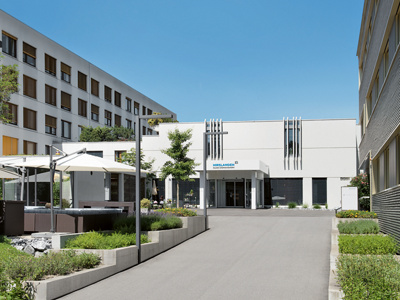Our body is our most valuable asset and is exposed to enormous stress over the course of a lifetime. At Hirslanden, we are committed to effective prevention - because prevention is always better than aftercare. But what happens if you do get a tweak? Our experts are there for you and support you in orthopaedics & sports medicine from prevention to therapy and rehabilitation - at all stages of life. With us, you will find outstanding expertise and care tailored to your needs.
We are not the only ones convinced of the quality of our services: according to Statista, 10 of our clinics are in the top 35 of the "Best Orthopaedic Specialist Clinics in Switzerland 2023".

Health & prevention
Certain diseases and disorders of the musculoskeletal system can be actively prevented or even counteracted. Even in cases of constant strain, advanced age or extensive exercise sessions, it is possible to avoid problems with the joins, tendons, ligaments and bones. This prevention comprises various areas. The goal of prevention is to avoid injuries and illnesses, as these result in limitations in daily life, at work and in sport.
Prevention: What you can do
Healthy and regular physical activity is important to keep our musculoskeletal system in good condition. You can find out how even beginners can use running as prevention here.
Also make sure to:
- Maintain a healthy weight. You can calculate your BMI here and find more detailed information.
- Eat a balanced diet. Especially when doing sport and exercise, it is important to get sufficient nutrition. You can find more tips about nutrition and exercise here.
- Avoid smoking
- Consume alcohol in moderation
- Put plans in place to prevent musculoskeletal injuries
- Have an ergonomic workplace in line with SUVA (link in german) and occupational safety regulations
- Have a sensible, varied training plan for exercise and sport activities, including performance diagnostics for optimum endurance and exertion planning.
An early detection check-up
To keep your musculoskeletal system healthy, you have the option to undergo a check-up. When performed regularly, these prevention programmes help to identify any health damage early and to determine treatment measures. This creates security.
You can find a list of our check-up centres and the preventive measures they offer here.
Personalised prevention
With Hirslanden Precise, we offer a comprehensive range of genetic medicine.Thanks to innovative methods, professional advice and support for prevention and early detection as well as diagnostics and therapy, we improve your quality of life based on your unique genetic requirements. Genetic medicine provides certainty about and self-determination in respect to your own health. This lets you learn how to keep your musculoskeletal system in good condition or how you can improve it with prevention measures tailored to you.
Sport & performance
Performance excellence: discover our sports medicine offer
Our sports medicine services support you in achieving peak performance and realising your full potential! We offer you a comprehensive range of individual performance diagnostics services so you can reach your athletic targets and even surpass them. With our highly qualified specialists and state-of-the-art equipment, we are your trustworthy partner on the road to sporting excellence.
Our services
Sports medical examinations
Comprehensive sports medical examinations, various lab tests for athletes, medical reports and electrocardiograms for integrated health monitoring.
Performance diagnostics – strength and stamina
Measurement of strength and stamina for detailed insights into your performance capabilities, allowing for effective planning of your training regime.
Radiology
Rapid diagnostic clarifications such as ultrasound, CT and MRI, precise investigations for optimal diagnostics.
Instrumental diagnostics
Heart function monitoring, lung function evaluation, conventional X-ray imaging for diagnosis of bone and joint function as well as anthropometric measurements for analysing the composition of your body and important parameters.
Other services
Innovative therapies such as acupuncture and autohaemotherapy, modern shockwave therapy and specialist pain therapies. We also offer orthopaedic consultations for children and adolescents, orthomolecular medicine, measurement of the spine, DXA measurement in the osteoporosis centre, lymph drainage and dietary consultations, supplements and regeneration.
My body is my most important work tool. That is why I take special care of it. Partnering with Hirslanden helps me with this. When I go to Hirslanden with a health concern, the whole team does everything to help me. I always go home with a clear answer and feeling good. Also, thanks to the large Hirslanden network, I always have access to the right specialist. I am very grateful to have Hirslanden at my side as a human and reliable partner in health matters.
Mujinga Kambundji, Swiss athlete
Our sports medicine offers for competitive and professional athletes

Orthopaedic diagnosis & treatment
A diagnosis that is as precise and comprehensive as possible provides the basis for suitable, individual treatment. The doctor can use various diagnostic procedures, which also help decide whether surgical or initially conservative treatment is needed.
Joints, ligaments, muscles and tendons come under a lot of stress in everyday life and over the years. Accidents and sports injuries such as cruciate ligament or meniscal damage, as well as diseases and chronic conditions – such as osteoarthritis and rheumatism – can mean things do not work smoothly any more. Thanks to orthopaedic diagnosis and treatment derived from this, we can look at the patient individually and provide medical help.
Orthopaedic diagnosis
The medical history, physical examinations and clinical tests, such as functional tests, are the first steps in orthopaedic diagnosis. Medical imaging is also often used. The most common types are:
- X-ray
- Computed tomography (CT)
- Magnetic resonance imaging (MRI)
- Ultrasound (sonography)
Orthopaedic treatment
Orthopaedic conditions and injuries can be treated conservatively or surgically. The most suitable measures depend on various factors, including biological or perceived age, actual age, other injuries, pain intensity or sensitivity, sports activity and finally also the patient’s individual needs.
Conservative treatment
With conservative treatment, therapy is accompanied by drugs and/or physiotherapy. Conservative treatment methods in orthopaedics include:
- Pain relief medication
- Ergotherapy
- Physiotherapy
- Massage
- Infiltration and injection techniques (e.g. for back pain)
Surgical treatment
Surgical treatment involves a surgical procedure. Most operations are currently now performed in a minimally invasive way, i.e. as little damage as possible is caused to the tissue because the procedure uses the smallest skin incision. Patients do not always have to stay in hospital overnight after surgery. Progress in medicine has now meant that many procedures can be done on an outpatient basis, without compromising quality. In particular, hand surgery procedures are often performed on an outpatient basis.
Common orthopaedic procedures include:
Our clinical pictures
Depending on the clinical picture, conservative treatment may be tried before an operation. Choose your clinical picture for further details:
Clinical pictures orthopaedic & sports medicine
As people get older, their bones, joints, spine and soft tissue become increasingly worn and damaged. Given that internal diseases such as diabetes and heart problems also increase with age, musculoskeletal rehabilitation often involves the treatment of multiple ailments. If several clinical pictures emerge at the same time, or if a person has undergone major musculoskeletal surgery, surgeons and attending doctors usually recommend an inpatient rehabilitation programme. However, if it is not necessary for the patient to stay at the hospital or clinic, they may be prescribed outpatient rehabilitation in the form of physiotherapy. This is often the case with acute, inflammatory and degenerative diseases if the patient is sufficiently mobile and independent.
Multiple therapeutic aims
Patients arrive in rehab with a diagnosis from their surgeon, specialist or family doctor, which is often accompanied by a list of therapeutic requirements. A comprehensive health assessment is conducted at the very beginning of the programme. Doctors, nurses, physiotherapists, occupational therapists and nutritional therapists consult with the patient and carry out examinations to determine their existing health problems. Based on these results, the team creates an individual therapeutic plan and prescribes an appropriate amount of pain relieving medication. They also determine whether the patient requires any medical aids, orthopaedic equipment, social services or psychological support.
Increased strength and stamina
In addition to measures for alleviating pain, musculoskeletal rehabilitation typically focuses on physiotherapy and occupational therapy. Patients who recently underwent surgery also receive the necessary nursing care. Every day patients undergo several active and/or passive treatments, individually or as part of a group. Elderly patients in particular are advised to switch to a protein-rich diet, as this supports muscle development. All the specialists involved in the rehab programme encourage patients to be as active as possible, because this increases their confidence in their own physical abilities.
An overview of the three types of rehabilitation
Outpatient rehabilitation (Physiotherapy)
People who are still largely able to live independently can complete their rehabilitation as outpatients. Outpatient programmes focus on active therapies such as physiotherapy, occupational therapy and medical training therapy. If these measures do not generate sufficient success, inpatient musculoskeletal rehabilitation provides another option for achieving the desired results.
Inpatient rehabilitation
Inpatient rehabilitation is advisable if pain or limited independence make outpatient care impossible. This type of rehab involves active forms of therapy such as physiotherapy, occupational therapy and medical training therapy, as well as medical care and support. Before the patient is discharged, the necessary follow-up care is discussed with their family or a home care provider, as is the possibility of extending the treatment in an outpatient setting. If necessary, issues related to social services will also be clarified. The patient’s family doctor and/or attending specialist receive a comprehensive final report.
Interdisciplinary outpatient rehabilitation
Interdisciplinary outpatient rehabilitation is based on the services provided during inpatient rehabilitation, however the patient stays at home rather than at the hospital. For this type of musculoskeletal rehabilitation, health insurance companies will only cover the costs if there is a reasonable expectation that the patient’s condition will improve.

We help with every episode in your life
We are your partner for all questions relating to your body's health: if you have any concerns or worries, we are always available for you via the Hirslanden Healthline.






